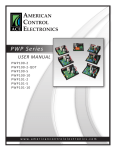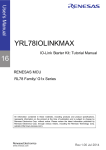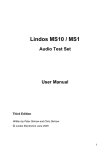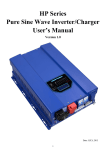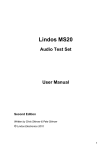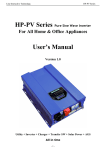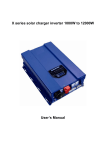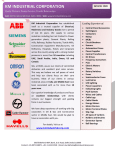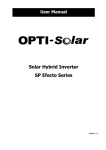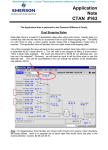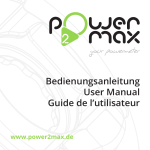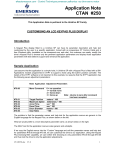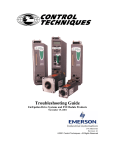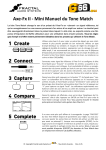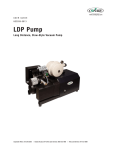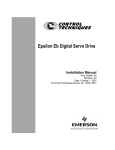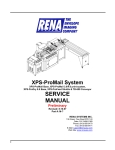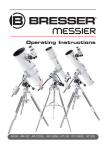Download Focus 1 Drive Manual
Transcript
Focus 1 ¼ to 2HP Single Phase, Uni-Directional Non-Regenerative DC Drive User Guide P/N: FOCUS1-UG Revision: A1 Date: Feb 10, 2005 © Control Techniques Drives, Inc. 2005 Page i General Information The manufacturer accepts no liability for any consequences resulting from inappropriate, negligent or incorrect installation or adjustment of the optional operating parameters of the equipment or from mismatching the variable speed drive with the motor. The contents of this User Guide are believed to be correct at the time of printing. In the interests of a commitment to a policy of continuous development and improvement, the manufacturer reserves the right to change the specifications of the product or its performance, or the contents of the User Guide, without notice. All rights reserved. No parts of this User Guide may be reproduced or transmitted in any form or by any means, electrical or mechanical, without permission in writing from Control Techniques. Page ii Customer Support Control Techniques 359 Lang Boulevard, Building B Grand Island, New York 14072 U.S.A. Telephone: (716) 774-1193 It is Control Techniques’ goal to ensure your greatest possible satisfaction with the operation of our products. We are dedicated to providing fast, friendly, and accurate assistance. That is why we offer you so many ways to get the support you need. Whether it’s by phone, fax or modem, you can access Control Techniques support information 24 hours a day, seven days a week. Our wide range of services include: Fax (716) 774-8327 You can FAX questions and comments to Control Techniques Just send a FAX to the number listed above. Website and Email www.emersonct.com Website: www.emersonct.com Email: [email protected] If you have Internet capabilities, you also have access to technical support using our website. The website includes technical notes, frequently asked questions, release notes and other technical documentation. This direct technical support connection lets you request assistance and exchange software files electronically. Technical Support (716) 774-1193 or (800) 893-2321 Email: [email protected] Control Techniques’ products are backed by a team of professionals who will service your installation. Our technical support center in Grand Island New York is ready to help you solve those occasional problems over the telephone. Our technical support center is available 24 hours a day for emergency service to help speed any problem solving. Also, all hardware replacement parts, if needed, are available through our customer service organization. When you call, please be prepared to provide the following information: The type of controller or product you are using What you were doing when the problem occurred How you tried to solve the problem Need on-site help? Control Techniques provides service, in most cases, the next day. Just call Control Techniques’ technical support center when on-site service or maintenance is required. Customer Service (716) 774-1193 or (800) 367-8067 Email: [email protected] Authorized Control Techniques distributors may place orders directly with our Customer Service department. Contact the Customer Service department at this number for the distributor nearest you. Page iii “Warning” indicates a potentially hazardous situation that, if not avoided, could result in death or serious injury. “Caution” indicates a potentially hazardous situation that, if not avoided, may result in minor or moderate injury. “Caution” used without the safety alert symbol indicates a potentially hazardous situation that, if not avoided, may result in property damage. Page iv Safety Considerations Safety Precautions This product is intended for professional incorporation into a complete system. If you install the product incorrectly, it may present a safety hazard. The product and system may use high voltages and currents, carry a high level of stored electrical energy, or are used to control mechanical equipment that can cause injury. You should give close attention to the electrical installation and system design to avoid hazards either in normal operation or in the event of equipment malfunction. System design, installation, commissioning and maintenance must be carried out by personnel who have the necessary training and experience. Read and follow this safety information and instruction manual carefully. Enclosure This product is intended to be mounted in an enclosure that prevents access except by trained and authorized personnel and prevents the ingress of contamination. This product is designed for use in an environment classified as pollution degree 2 in accordance with IEC664-1. This means that only dry, nonconducting contamination is acceptable. Setup, Commissioning and Maintenance It is essential that you give careful consideration to changes to drive settings. Depending on the application, a change could have an impact on safety. You must take appropriate precautions against inadvertent changes or tampering. Restoring default parameters in certain applications may cause unpredictable or hazardous operation. Safety of Machinery Within the European Union all machinery in which this product is used must comply with Directive 89/392/EEC, Safety of Machinery. The product has been designed and tested to a high standard, and failures are very unlikely. However the level of integrity offered by the product’s control function – for example stop/ start, forward/reverse and maximum speed – is not sufficient for use in safety-critical applications without additional independent channels of protection. All applications where malfunction could cause injury or loss of life must be subject to a risk assessment, and further protection must be provided where needed. Page v General warning Failure to follow safe installation guidelines can cause death or serious injury. The voltages used in this unit can cause severe electric shock and/or burns, and could be lethal. Extreme care is necessary at all times when working with or adjacent to this equipment. The installation must comply with all relevant safety legislation in the country of use. AC supply isolation device The AC supply must be removed from the drive using an approved isolation device or disconnect before any servicing work is performed, other than adjustments to the settings or parameters specified in the manual. The drive contains capacitors, which remain charged to a potentially lethal voltage after the supply has been removed. Grounding (Earthing, equipotential bonding) The drive must be grounded by a conductor sufficient to carry all possible fault current in the event of a fault. The ground connections shown in the manual must be followed. Fuses Fuses or over-current protection must be provided at the input in accordance with the instructions in the manual. Isolation of control circuits The installer must ensure that the external control circuits are isolated from human contact by at least one layer of insulation rated for use at the applied AC supply voltage. Page vi Table of Contents Topic Introduction Motor Compatibility Basic Control Modes/Feedback Page Quick Stops Receiving, Inspection, Storing Performance Features Nameplate Information Nameplate Location Catalog Number Definition 9 10 12 12 12 13 14 15 15 16 Specifications Ratings Table Performance Specifications Operating Conditions Internal Adjustments (Potentiometer) Customer Selections (Jumpers) Operator Functions Control Circuit Specifications Options Dimensions Option Kits & Descriptions 16 17 17 17 17 18 18 18 19-20 21-24 Armature Voltage Feedback Customer Connections & Start-Up Start-Up Guidelines Incoming Power Requirements Grounding Motor Wiring 26 26 26 26-27 When viewing this document electronically, the Table of Content items are active and will direct you to that topic by clicking on that item. Page 7 Table of Contents Topic Page Power Wiring 28 Control Wiring Speed Pot Wiring 29-31 32 Customer Selections Jumper Programming Current Ranges Current/Torque Control LED Status Indicator Potentiometer Adjustments Basic Adjustments Tuning Adjustments 34-38 35 36,48 37 38-40 38-39 40 Interconnect Drawings Functional Block Diagram Circuit Overview 47 48 Start-up Guide Worksheet 41-43 Application Safety System Interface Suggestions 44 45 Initial Start-Up & Basic Test Setups Installation of Option Kits Motor Test 46 46 53-55 Trouble Shooting Guide Oscilloscope Safety Light Bulb Test 49-56 51 57-58 Application Notes 59 Drive Isolation 60-62 Spare Parts 63 When viewing this document electronically, the Table of Content items are active and will direct you to that topic by clicking on that item. Page 8 Introduction This is the User’s Guide for Focus 1 (Non-regenerative) series of DC Drives. The Focus 1 is a 2nd generation product of the long-standing Focus series. The Focus 1 was introduced back in 1980. The Focus 1 non-regen drive remains as a popular single-phase, uni-directional analog drive for DC motors with power ranges from ¼ to 2HP. Your Focus 1 is a general purpose non-regenerative DC motor speed controller that is powered from either 115Vac or 230Vac single phase power. A non-regenerative (single quadrant) drive is one that can provide motoring torque for acceleration and to overcome rated loads. There are a great many applications where non-regenerative drives provide the most economical solution. A non-regenerative drive however cannot slow down a motor faster than the motors normal coasting rate (unless a Dynamic Braking stop is commanded) nor can it stop overhauling load situations. For more demanding applications, a sister drive- the Focus 3 Regen (regenerative model), offers full four quadrant operation for bi-directional motor control and controlled deceleration as well as opposition to overhauling loads. Focus 1 drives come in two basic model variations- with and without enclosure. Chassis Model The model without an enclosure is denoted as a chassis model. The chassis model is intended for mounting within a User supplied cabinet and where the User intends to provide remote Start/Stop and Speed control signals. Enclosed Model The Enclosed version comes to you already in a NEMA 1 enclosure that would allow the User to mount the Focus on a wall or machine surface. The Enclosed version has Power On/Off Switch, a spring to center Start/Stop switch and the Speed Control adjustment right on the front cover for convenient operation. For additional environmental protection, a NEMA 4/12 option kit is available. For a complete overview of the Focus 1 product line and available options, visit our website at: www.emersonct.com or click the link below: Focus 1 Catalog Section Page 9 Motor Compatibility The Focus 1 was designed to run standard 90 Vdc or 180 Vdc Shunt Wound or Permanent Magnet DC motors in one direction. The Focus 1 can run motors with other characteristics (such as Universal motors) but one must review those requirements to insure compatibility. Universal motors have commutator brushes but typically plug into the AC power line. Universal motors are often used in tools such as Drills, Saws, Shop VAC’s, Routers, etc and typically direction cannot be reversed. Shunt Wound Motors that are controlled by single phase DC drives typically have 4 power wires. Two of these are the Armature leads typically designated A1 & A2 or A+ & A-. The other two power wires are the shunt field leads and typically designated F1 & F2 or F+ & F-. The Focus 1 can supply up to 1 Amp for shunt field excitation (field current requirements beyond 1A may damage field rectifier diodes). If your motor does not have Field Current information on the nameplate, you can determine compatibility by measuring your motors Field resistance using a calibrated ohmmeter. Motors with: 90v Armatures typically require 100 Vdc for field excitation. In these cases, the Focus 1 requires 120vac input power and must be internally set for this input level. The motor Field resistance should not be less than 100 ohms when cold. 180v Armatures typically require 200 Vdc for field excitation. In these cases, the Focus 1 requires 240vac input power and must be internally set for this input level. The motor Field resistance should not be less than 200ohms when cold. The motor nameplate information is key to determining compatibility. As seen below, the motor below easily falls in the range of the Focus 1 operated from a 240vac supply. The drive will supply 180v for the armature and 200v for the field ( this motor indicates there are 2 field windings and for 200vdc they must be wired in series ). The field current requirement is 0.28A which is well under the 1A maximum. 1 1750 / 2050 5.0 0.28/.22 180 SHUNT 518 FLD VOLTS 200/100 240v Armatures typically require 150 Vdc for field excitation. In these cases, the Focus 1 requires 240vac input power and must be internally set for this input level. The motor field resistance should not be less than 150 ohms when cold and will require a series resistor to drop the additional field supply voltage. Consult Control Techniques Technical Support for additional information. Page 10 Motor Compatibility Motors with: Permanent Magnet Motors typically have only 2 power wires. These are the Armature leads and typically designated A1 and A2 or A+ and A-. The Focus 1 is compatible with most all PM motors having either 90v or 180v armatures. Armature Voltage Armature Current Permanent Magnets Page 11 Speed Control Armature Voltage Feedback The Focus 1 varies the speed of the motors mentioned above as a function of the Speed potentiometer setting (or external speed command signal) by simply varying the output Armature voltage (field excitation if used typically remains constant). Armature Voltage Feedback (or simply Armature Feedback) does not require any special motor mounted speed feedback device and is therefore inherently quite reliable and is capable of providing up to 1% speed regulation. Quick Stops A non-regenerative drive cannot stop a motor faster than the motors normal coasting rate unless a Dynamic Braking resistor is employed. The DB option provides a rather quick stopping action and provides motor turning resistance when the drive is not in the RUN condition. The Focus 1 can be outfitted with a Dynamic Braking resistor should this requirement be desired. Note: DB Resistors require Contactor Option - See Options Power Outages Shunt Wound Motors Should a power outage occur, the drive would turn off and the motor would coast to rest. If a Dynamic Braking resistor were employed there would typically be enough decaying field strength to enable some faster stopping action but this should be tested from full speed to determine if power outage stopping time is sufficient should this factor be a safety consideration for your application. Permanent Magnet Motors Should a power outage occur, the drive would turn off and the motor would coast to rest. If a Dynamic Braking resistor were employed, full Dynamic Braking force would be exerted because the field is maintained by the motors internal permanent magnets. Therefore, there would be motor turning resistance during power outages as well. Page 12 General Information Introduction The purpose of this manual is to provide the user with the information needed to install, start-up, and maintain the Focus 1 drive. This instruction manual should be read in its entirety, paying special attention to the warning and caution notices, before installation and before performing any start-up or drive maintenance. Receiving The user is responsible for inspecting the equipment thoroughly before accepting the shipment from the freight company. Check the items received against the purchase order. If any items are obviously damaged, do not accept delivery until the damage has been noted on the freight paperwork. Inspection Before installation and start-up of the drive, inspect the unit for mechanical integrity (i.e. loose parts, wires, etc). If physical damage was sustained during shipment, leave the shipping container intact and notify the freight agent. After unpacking, check the drive nameplate catalog number against the purchase order. See page 15 for nameplate location. Storing Store the drive in its shipping container prior to installation. If the drive isn’t used for a period of time, store according to the following instructions in order to maintain warranty coverage: Clean, dry location Ambient Temperature Range: -400C to 700C :-400F to 1600F Humidity: 95%, Non-condensing Improper procedures can result in personal injury or equipment damage. Only qualified electrical maintenance technicians familiar with electronic drives and their standard safety precautions should be permitted to install, start-up, or maintain this apparatus. Page 13 PERFORMANCE FEATURES • Solid State Full Wave Power Bridge -Uses generously rated power semiconductors for Maximum reliability and long life. • Inner Current Loop Regulator - Inherent high bandwidth capability for fast response. • Fusing - Both AC lines fused for maximum protection in case of short circuit. • AC Line Filter and Transient Voltage Suppressor Network - Eliminates interaction between other drives or AC equipment. • Current Limit Ranges - Selectable current limit ranges to match the drive to the motor being used. Provides smooth acceleration of high inertia loads. • Speed Regulator - 1 % accuracy armature voltage feedback with IR compensation • Current (Torque) Regulator 2% accuracy armature current regulator allows the user to control motor torque instead of speed. • Circuit Board Indicator – A Light emitting diode (LED) on the control board indicate when the drive is active in the Run Mode. • • UL/cUL - All Focus 1 Drives are UL/cUL listed. • One cannot make a connection to ground or a grounded device to any terminal or connection point to the Focus 1 Non-Regenerative Drive without causing drive damage. Such failures unfortunately cannot be warranted. • See Ways of Achieving Isolation on page 60 of this manual Page 14 The Focus 1 comes in two basic model variations- with and without enclosure. Chassis Model The model without an enclosure is denoted as a chassis model. The chassis model is intended for mounting within a User supplied cabinet and where the User intends to provide remote Start/Stop and Speed control signals. Enclosed Model The Enclosed version comes to you already in a NEMA 1 enclosure that would allow the User to mount the Focus on a wall or machine surface. The Enclosed version has a Power On/Off and spring to center Start/Stop switches and the Speed Control adjustment on the front cover for convenient operation. Nameplate Information Serial # Part # Enclosed Unit P/N 2400-8001 5507051 Chassis Unit Always record the drive Model Number, Part Number and Serial Number for future warranty situations and spare parts. A good location to record these is on the Start-up Guide Worksheet on page #41. Page 15 Specifications Ratings Catalog Part # 24008001W 24008000W Page 16 Enclosure Chassis NEMA 1 AC Input 1Ø Max Volts Amps ¼ -1 120 14 ½-2 240 14 ¼ -1 120 14 ½-2 240 14 HP DC Armature Volts 90 180 90 180 Output Armature Amps 10 10 10 10 Field Volts 100 200 100 200 Field Amps 1 1 1 1 PERFORMANCE SPECIFICATIONS Service Factor 1.0 Speed Regulation (95% Load Change): Armature Voltage 1% of Max. Speed with IR Compensation All other variables (voltage regulated) 15% of Base Speed Speed Range: 30:1 Efficiency: Control Only 98% Drive System (motor and control) 86% typically DRIVE OPERATING CONDITIONS Altitude (without derating) Ambient Temperature: Chassis Models Enclosed (NEMA 4/12) 3300Feet or 1000meters 0-550C (32 to 130° F ) 0-400C (32 to 104° F ) INTERNAL ADJUSTMENTS (POTENTIOMETERS) Potentiometer Function Maximum Speed Minimum Speed IR Compensation Range 70-115% of Rated Speed (~60vdc-105vdc w/120vac input) (~120vdc-210vdc w/240vac input) 0-30% of Maximum Speed 0-20% of Rated Voltage Internal Factory Settings Current Limit Acceleration Time Deceleration Time Fixed at 150% of Selected Range Fixed 2-3 seconds (linear) Fixed 2-3 seconds (linear) CUSTOMER SELECTIONS (JUMPERS) Function Input Voltage Control Mode Current Feedback range Armature Voltage level Optional “M” Contactor Range 120/240Vac Speed / Torque High / Medium / Low 90 Vdc/180 Vdc Yes/No Page 17 OPERATOR FUNCTIONS Speed Adjustment (Speed Pot) Start/Stop Forward/Reverse Chassis Enclosed Standard Customer Supplied Optional Standard Standard Optional CONTROL CIRCUIT SPECIFICATIONS Logic Control Power 24 Vdc Speed Potentiometer 5000 ohms Input Signal Requirement 10 Vdc @ 0.2mA (44Kohm input resistance) Control Circuit Isolation Optional FOCUS 1 OPTIONS CATALOG NUMBER DESCRIPTION 2400-9001 M-Contactor Kit F3DB124 F3DB0524 F3DB112 Dynamic Braking Kits F3TS F3NSBD 2950-9066 2950-9068 6160-9001 Toggle Switch, NEMA 4 /12 Signal Isolation Board Remote Operator Station ( 3 Function ) Remote Operator Station ( 5 Function ) Ten-Turn Precision Potentiometer Remote Percent Speed Meter Kit Page 18 ¾ -1HP @ 240V ½ HP @ 240V ¾ -1HP @ 120V Focus 1 Chassis Dimensions Chassis Suitable for mounting in a user’s enclosure where internal temperatures will not exceed 550C or 1300F. 2400-8001W Page 19 Focus 1 Enclosed Dimensions NEMA 1 Suitable for most well ventilated factory areas where industrial equipment is installed. Locations subject to steam vapors, oil vapors, flammable or combustible vapors, chemical fumes, and corrosive gases or liquids should be avoided unless an appropriate enclosure has been supplied. Ambient temperature is not to exceed 400C (104 0F). Depth 5 inches maximum 2400-8000W Page 20 Focus 1 Option Kits Focus 1 Contactor Kit – P/N 2400-9001 This Kit includes a magnetic contactor that can be mounted either in the Focus 1 enclosed unit or on the chassis mount unit. It provides a positive disconnect of the motor armature when the controller is stopped, preventing motor rotation in the event of SCR mis-fire due to line noise. This kit may also be required by local and/or National Electrical Codes. This kit also includes the DB (dynamic braking) poles, an auxiliary normally open contact and all connection wires. Focus 1 Reversing Kit – P/N 2400-9001 This Kit includes a magnetic contactor that can be mounted either in the Focus 1 enclosed unit or on the chassis mount unit. It provides a positive disconnect of the motor armature when the controller is stopped, preventing motor rotation in the event of SCR mis-fire due to line noise. This kit may also be required by local and/or National Electrical Codes. This kit also includes the DB (dynamic braking) poles, an auxiliary normally open contact and all connection wires. Focus 1 Dynamic Braking Kit PN– See Table Below Requires contactor kit For use with Focus 1 Contactor Kits. Dynamic braking provides rapid motor stopping by quickly dissipating the stored energy in the rotating motor and load. These resistors have been sized in accordance with Nema specifications for dynamic braking. “Providing 3 stops in rapid succession with the load inertia equal to the motor inertia, then cooling forever.” AC Input 120 Vac 240 Vac HP (Typical) 1/4-1/3 1/2 3/4-1 1/2 3/4-1 1.5 2 Part Number F3DB1524 F3DB224 F3DB112 F3DB0524 F3DB224 F3DB1524 F3DB224 Page 21 Focus 1 Option Kits Focus 1 Nema 4/12 Kit– P/N 2400-900 This Kit is used to convert the standard Nema 1 enclosure to a Nema 4/12 rating suitable for “wash down” environments. Included in the kit is a gasket to seal the connection between the upper and lower enclosure sections, three boot seals for the switches for the Start / Stop, AC power On/Off and optional Fwd / Rev switches, and a shaft-sealing not for the speed potentiometer. Signal Isolator Board – P/N F3NSBD This option is used in applications where isolation is required between an external control signal and the motor controller (which may or may not be at earth ground potential). It can be utilized to isolate a variety of voltage or current signals (see specifications below). It may also be used simply to isolate the speed adjustment pot, and the pot power supply is included. This option can be mounted in the enclosure or in a piece of plastic track (included with kit). Specifications: Input Power: 17- 30 Vdc @ 50mA Max. (for control circuitry) Control Relay (CRR): 24 Vdc @ 12.1 mA (JP5 = 24 Vdc) 120 Vac @ 20 mA (JP5 = 120 Vac) Contact Type/Rating – 2 Form A / 1A @ 250 Vac Isolation Voltage: 240 Vac Power Systems 2000 Vac Hi-Pot for 1 Minute Inputs: Voltage Ranges: 5,12,26,52,98 & 208 Vdc, 180 Ohms/volt Current Ranges: 0-5 mA, 1-5 mA, 910 Ohms input impedance 0-20 mA, 4-20 mA, 250 Ohms input impedance Speed Pot: 5Kohms, 2W (Includes +10 Vdc power supply for potentiometer) Output: 0 to +10 Vdc (Uni-polar) Page 22 Focus Family Options Speed Remote Operator Station – P/N 2950-9068 /2950-9066 Speed Run Jog Start Auto Man Stop Start These NEMA 1 operator stations can be used to remotely control Focus 1 Motor Controllers. Two models are available as shown. Both units include a Speed Potentiometer, a green normally open start button and a red normally closed stop button. The 2450-9068 also includes two 2 position switches with two contacts, 1 normally open, 1 normally closed. -9066 Stop -9068 50 25 0 75 100 Remote Percent Meters – P/N See Accessories Catalog This meter may be used to remotely display the motor speed in percent of maximum speed. Included is a calibration board. It is available in left zero (unidirectional applications) or 0-center (bidirectional applications) Meters supplied loose for customer mounting. 100 75 50 25 0 25 50 75 100 P/N M1 M2 M3 M4 Meter Meter 0 - 100 Meter 0 - 150 Meter 100 –0 -100 Meter 150 –0 -150 P/N C1 C2 C3 Calibration board Cal+/-10vdc Cal-90vdc Cal-180vdc Ten-Turn Precision Speed Potentiometer – P/N 6160-9001 This is a multi-turn speed potentiometer. It provides a vernier scale for precise and repeatable speed setting. A locking tab is provided to prevent in advertent speed changes. It may be mounted in the Focus 1 enclosure or the Remote Operator Station described above. Page 23 Speed Potentiometer – P/N SpdPot This potentiometer can be used for either a remote speed command potentiometer or a remote current limit potentiometer. The following kits are available for the Focus series of drives. They are designed to provide a 120-Vac interface for applications requiring remotely mounted industrial operator devices (i.e. Operator Stations shown on previous page). 120Vac Interface – P/N ACIF-2R-Focus . This kit provides 120vac interface to a Focus 1 to provide a three wire Start / Stop pushbutton arrangement and either a Jog pushbutton or a Forward / Reverse selector function. RR JR 120Vac Interface – P/N ACIF-2R-R/S-ET . This kit includes a System Ready/External Trip function similar to that described in the Suggested System Interface section - see Application Safety RR These options are used with the chassis mount controls and include Din rail for panel mounting in the customer’s enclosure, other configurations available – Consult Factory. Page 24 ET Customer Connections & Start-Up NOTE Read this manual in its entirety, paying particular attention to the Warnings and Cautions in each section before installing, starting, or maintaining this drive. Improper procedures can result in personal injury or equipment damage. Only qualified electrical maintenance technicians familiar with electronic drives and their standard safety precautions should be permitted to install, start-up, or maintain this apparatus. Start-up Guidelines STEP 1: STEP 2: STEP 3: STEP 4: STEP 5: STEP 6: STEP 7: Receiving & Inspection Drive Installation . . . Power Wiring Control Wiring Jumper Programming Potentiometer Adjustments Start-up of Drive Page 13 Page 25 Pages 26-28 Pages 29-31 Pages 33-36 Pages 38-40 Page 41-48 Installation of this equipment must be done in accordance with the National Electrical Code and all other applicable regional or local codes. Proper grounding, conductor sizing, and short circuit protection must be installed for safe operation. Improper installation or operation of this control may cause injury to personnel or damage to equipment. Hazardous voltages may be present on external surfaces of ungrounded controls. This can result in personal injury or equipment damage. When performing visual inspections and maintenance, the incoming AC power must be turned off and locked out. Hazardous voltages will be present until the AC power is turned off. The drive contactor ( if used ) does not remove hazardous voltages when opened. Page 25 Incoming Power Requirements A remote fused AC line disconnects or circuit breaker installed ahead of the control is required by the NEC (National Electrical Code). The control is designed to accept single-phase AC line voltage. Grounding The control must be connected to earth ground either via mounting screws provided by an enclosure or chassis-installed screw or by using the Earth Ground lug provided on the drive heatsink, for safety of operating personnel. The ground wire should be of the same gauge as the AC Input wires and must be connected to the panel or enclosure frame for personal safety. Wiring Guidelines for Focus DC Drives Check drive nameplate data for conformance with AC power source and motor AC HP Fusing ¼ -1 ½-2 15 Amp 250Vac Volts 120 240 Input Max Amps 14 14 Wire Armature DC Output Armature AWG #14 Volts 90 180 Amps 10 10 Wire AWG #14 Shunt Field Field Field Volts 100 200 Amps 1 1 Wire AWG #14 Notes: All wiring based on 75°C copper wire, types FEPW, RH, RHW, THHW, THW, THWN, XHHW, USE, ZW Wire gauge size based on 30°C maximum ambient and no more than three conductors in a raceway or cable and 1.25 service factor. Please refer to National Electric Code Table 310-16 for additional information. Wiring must also meet any Local Codes. Do not place knife switches, polarity reversing switches, reversing contacts in the armature or field circuits. During normal operation, keep all covers in place and cabinet doors shut. Page 26 Motor Thermal Switch For Motor Thermostat wiring, see the “Control Wiring” section. Wrong Motor Rotation If the motor rotates in the wrong direction, one of the following changes will correct it: Only With Power Removed Exchange Al and A2 output Motor Armature leads. or Exchange Fl and F2 Motor Shunt field leads. Installation of Option Kits Do not install option kits until you have verified the basic operation as outlined in the Start-Up section. Pre-installation of option kits before verification of basic drive operation will make troubleshooting much more difficult. Option kits are often installed incorrectly and one cannot determine if the drive was functional before kits were installed. When making any wiring or jumper changes, the incoming AC power must be turned off and locked out. Hazardous voltages will be present until the AC power is turned off. The drive contactor ( if used ) does not remove hazardous voltages when opened. Page 27 Drive Power Wiring Focus 1 Models AC Line Input F+ F- A- A+ Earth Connection A+ & A- are the motor Armature leads F+ & F- are a shunt wound motors Field leads ( they will not be present on Permanent Magnet or Universal Motors ) Page 28 Control Wiring TERMINAL CONNECTIONS (TB2) & DESCRIPTIONS Pin Number 1 Forward: Connected to “quick connect” 1 as a tie point for the Motor Reversing Contactor Kit forward / reverse switch, or the motor contactor Kit 2 Reverse: Connected to “quick connect” 1 as a tie point for the Motor Reversing Contactor Kit forward / reverse switch. 3 +24 Vdc Supply: Powers the logic inputs to the drive. It is not intended for it to be used to power external circuits. External use will void warranty. 4 Run Relay Contact: Relay common connection for seal-in circuit. 5 Run Relay: When +24 Vdc is applied to this terminal, the Run relay picks up, the Speed loop and the Current loop are enabled, and the clamp on the SCR firing circuits is released. 5A Motor Thermal tie-point: No connection internal see Application Safety 6 +10 Vdc Speed pot supply voltage: Maximum load is 5ma 7 Standard Speed command input: Typically this input is connected to the wiper of the speed pot wiper. Input impedance: 40Kohm. 8 Minimum Speed connection: This sets a minimum motor speed when the speed potentiometer is used (does not set a minimum speed when an isolated 0 to 10vdc speed reference is used). The Focus 1 drive control circuitry is not isolated *. No points in the control circuitry, including common, should be connected to earth ground unless specifically shown on the supplied wiring diagrams. No grounding connections should be made on the terminal block. Improper connections to ground, including speed potentiometer connections, will result in immediate control failure and will void the factory warranty. * See How to Achieve Isolation on page 60 of this manual Page 29 Page 30 Terminal Strip Connections Enclosed Model Standard Start / Stop & Speed Potentiometer Connections TB2 1 2 3 Stop Start The Start/Stop Switch And the Speed Potentiometer are supplied as shown on the drive cover 4 5A 5 6 7 8 Speed Potentiometer Drive will not start without this. This is intended for system interlock- see Application Safety Page 31 Chassis Model The Chassis Model has no operator devices connected to the drive control terminal strip. The only connections made are connections from terminal #3 to #4 which is required for three wire Start/Stop controls. The Speed Potentiometer is supplied “loose” with the drive. 1 2 3 Stop 4 5A Start 5 6 7 Stop Potentiometer 8 Drive will not start without this. This is intended for system interlock- see Application Safety Page 32 Standard Unipolar Speed Potentiometer Wiring +10vdc Speed Command 6 Wiper 7 CCW Common/ Min Speed CW 8 Speed Pot Rear View CCW=counter clockwise Cable should be 3 conductor with overall shield w/pot end tied off and dressed. Cable and pots are available from: Control Techniques Service Center @ 1-800-367-8067 Cable P/N 3CONCBL-XXX (XXX in feet) Speed Potentiometer P/N SpdPot Do Not Connect shield to Earth. This will result in permanent damage to the Drive and will not be covered under WARRANTY Page 33 Customer Jumper Selections Jumper Programming Equipment damage and/or personal injury may result if jumper programming is attempted while control is operational. Always lock out power at the remote disconnect before changing jumper positions. See page 33 for jumper locations JUMPER DESCRIPTION RANGE FACTORY SETTING J1 Speed or Current Control Mode (see next page) Speed or Current (SPD) (CUR) Speed J3 Armature Voltage Level Selector LOW (90 Vdc) or HI (180 Vdc) HI (180 Vdc) Use care when setting J3 as the upper 2 pins are to be set when J1 is in the SPD position. J1 J3 Page 34 Input Voltage Selection Input Line Voltage 120Vac 240Vac Jumper Positions A to E and B to D A to C and B to C Items in BOLD RED are factory set positions This photo shows the drive settings for 115vac operation Caution Application of 240vac to a unit set up for 115vac ( as shown above ) will damage the drive and void the warranty. When making any wiring or jumper changes, the incoming AC power must be turned off and locked out. Hazardous voltages will be present until the AC power is turned off. The drive contactor ( if used ) does not remove hazardous voltages when opened. Page 35 Current Feedback Range (J2) For 115vac Operation on 90vdc motors Motor HP Range 1/4 1/3 1/2 3/4 1 DC Output Current (Amps) 2.6 3.7 5.5 7.5 10 J2 Jumper Position Lo Lo Lo Med Hi For 230vac Operation on 180vdc motors Motor HP Range 1/2 3/4 1 1-1/2 2 DC Output Current (Amps) 2.6 3.7 5.5 7.5 10 J2 Jumper Position Lo Lo Lo Med Hi J2 -- Max Output Current Select based on motor Armature requirements Page 36 Current Control Mode Focus 1 Drives can be configured to operate in the Current Control Mode which is often referred to as making the drive a “Current Regulator”. Since motor torque is directly proportional to the armature current, a drive configured as a Current Regulator is often referred to as a “Torque Regulator”. If using the Focus drive as Torque Regulator, make the following adjustments: J1: J2: J3: Select current (CUR) control ( upper two pins ) Select the appropriate current feedback range. Select CURR REG, lower two pins. J1 J2 J3 In Torque control mode, the motor speed is determined by how much load there is on the motor and the torque level set on the drive. If torque in the motor (as set by the Drive) is set to a level higher than what is required to move the load, the motor will accelerate in speed until either the load from the motor increases to the level set by the drive or the drive reaches its maximum output voltage (as set by the line voltage). In the case of a lightly loaded motor, the motor could accelerate to almost twice-base speed under these conditions. In this mode the user be aware of this and MUST PROVIDE OVERSPEED PROTECTION. A contact from an OverSpeed sensor could be placed in the System Interlocks- see Application Safety Page 37 LED Status Indicators Run LED – This red led will illuminate any time the run relay is energised Run LED Page 38 Basic Customer Adjustments Maximum Speed (MAX SPD) The MAX SPD pot sets the maximum motor speed (80-120% of motor base speed) allowed. It is factory preset to the midway position. Note: Do not exceed motor nameplate maximum speed rating. With the motor running, turn the speed pot on the drive enclosure cover/operator control panel fully clockwise while monitoring actual motor RPM or by measuring the Armature Voltage on A+ & A-. Then, adjust the MAX SPD pot on the control board to set the desired maximum motor speed. Do not exceed the motors Armature Voltage nameplate rating. Minimum Speed (MIN SPD) The MIN SPD pot sets the minimum speed (0-30% of maximum speed setting) at which the motor will run. It is factory preset at its full counterclockwise position. With the motor running, turn the speed pot on the drive enclosure cover/operator control panel fully counterclockwise. Adjust the MIN SPD pot clockwise until the desired lowest motor speed is reached. Page 39 Basic Customer Adjustments MIN SPD Adjust for minimum Motor speed MAX SPD Adjust for maximum Motor speed Page 40 Additional Tuning Adjustments Internal Resistance Compensation ( IR COMP ) Compensation pot is used to overcome the motor’s natural tendency to slow down as the load increases. If the motor slows down excessively as it is loaded, adjust the IR COMP pot clockwise to recover speed lost during the loaded condition. The motor will oscillate in speed or “hunt” if the IR COMP pot is adjusted too far clockwise. If this pulsing of speed occurs, adjust the IR COMP pot counter clockwise until the motor speed stabilizes. IR Comp Adjust for motor speed droop due to load Page 41 Start-up Guide Worksheet Improper procedures can result in personal injury or equipment damage. Only qualified electrical maintenance technicians familiar with electronic drives and their standard safety precautions should be permitted to install, start-up, or maintain this apparatus. At this point all INPUT POWER must be OFF ! Obtain the following information: Focus Drive Model 2400-8000 2400-8001 a) AC Input Line Voltage Drive Serial Number Drive Part Number _____________ 240 Vac 120 Vac b) Motor Nameplate Information: Armature Voltage Armature Current Field Voltage Field Current Rated RPM Regulation Mode _________Vdc _________A _________Vdc _________A _________ rpm Speed ( most common case ) Torque ( read first ! ) Focus drives come to you factory set for Speed Regulation mode which is the most common case. Even if your application requires Torque control, we would strongly suggest that you first run your motor Speed Control initially. After you have verified proper operation in the Speed mode, you could then switch over to Torque mode after reading about the Current Regulation Mode. Page 42 Focus 1 Jumper Setup Worksheet Refer to the data recorded on the previous page for this worksheet Refer to your motor nameplate data. STEP 1 Does your motor have a shunt field winding? If No go to STEP 5 otherwise go on. STEP 2 Is your motor field current greater than 1.1A? If No, go to STEP 3 If Yes STOP The Focus 1 Field Supply rectifier will be damaged!!! Call Tech Support for a solution. STEP 3 If your motor field voltage is 100 Vdc, then you must use 120 Vac for Input Power ----- Transformer Programming Set JP3 to Low then go to STEP 7 BA B D A E CC If you must use 240 Vac ----- Call Tech Support for a solution otherwise go to STEP 4 STEP 4 If your motor field voltage is 200 Vdc, then you must use 230 Vac for Input Power ---Set JP3 to Hi then go to STEP 7 Transformer Programming BA B D A E CC otherwise STOP ---- Call Tech Support for a solution STEP 5 If your motor armature voltage is greater than 110 Vdc, hen you should use 230 Vac for Input Power ---Set JP3 to Hi then go to STEP 7 Transformer Programming BA B D A E CC If you must use 120 Vac ---- Call Tech Support for a solution otherwise go to STEP 7 STEP 6 If your motor armature voltage is less than 110 Vdc, then you must use 115 Vac for Input Power ----Set JP3 to Lo then go to STEP 7 Transformer Programming BA B D A E CC Page 43 Armature Current Programming - (J2) Current Feedback Range STEP 7 Set jumper J2 to the range that matches up most closely with your motors Armature Amp rating from the table below: FOCUS Catalog Number 2400-8000 or 2400-8001 DC Output Current (A) 5.5 7.5 10 J2 Jumper Position Lo MED HI When making any wiring or jumper changes, the incoming AC power must be turned off and locked out. Hazardous voltages will be present until the AC power is turned off. The drive contactor ( if used ) does not remove hazardous voltages when opened. Page 44 Application Safety When applying a motor drive in a manufacturing process, one must understand that the motor drive merely provides the energy for a motor to turn and it will do so without regard upon activation and command. There could be failure modes in any external interface equipment and/or the Focus drive itself that could cause the motor to turn suddenly at any speed or cause it to fail to stop on command without warning. When considering Operator safety the Installer must include and employ additional equipment to provide safeguards to insure Operator safety. Consult all NEC and OSHA machine safety recommendations and guidelines. These safeguards are the sole responsibility of the Installer. For these reasons, the Installer must envision all, implement all and test or simulate all failure methods. The Installer is responsible for his/her resulting implementation to insure safe and reliable operation of the installation. In addition, the Installer should provide the End User of his Installed system with a System User’s Manual and instruct the User/Operator on correct/safe operation. Instruction should include the demonstration and purpose of safety features that you the Installer has included and the importance of periodic testing to insure they do indeed operate as designed. The Installer should instruct, inform and warn his End User customer against bypassing the safety permissives the Installer has provided. NOTE: Without the use of the Contactor option, P/N 2400-9001 (or the Reversing Contactor option, P/N 2400-9002, if reverse is required) potential motor movement in the event of a power line disturbance (causing an SCR (power device) to misfire) can occur since the motor is connected directly to the power circuit even when the drive is disabled. It is highly recommended that one of these contactor kits be used to guard against such occurrences. When making any wiring or jumper changes, the incoming AC power must be turned off and locked out. Hazardous voltages will be present until the AC power is turned off. The drive contactor ( if used ) does not remove hazardous voltages when opened. Page 45 System Interface Suggestion A fundamental basic system interface suggestion would be to always employ a method to supply a “permissive” or System Enable to allow the drive system to work if all things on the machine are alright. This interface would provide a method to keep the System disabled if certain key safety permissives are not satisfied. The installer should instruct, inform and warn his End User customer against bypassing the safety permissives the Installer has provided. The System Enable function would also have the ability to disable the drive if it was in operation and some safety device were tripped or if the Operator encountered a need to request an Emergency Stop for instance. The external relay logic system outlined below would provide a basic yet effective method of supplying an overall System Enable for a Focus Drive installation. 115vac Emergency Stop Stays in when pressed Pull to Reset Machine Ok to Run ( Enable) Enable Machine SYSRDY Keyswitch or similar to enable machine Motor Thermal Switch SYSRDY System Ready All other safety interlocks such as but not limited to: Light Curtains, Overspeed or Over-Travel Limit Switches, Safety Gates/Ropes, Two Hand palm buttons, Jam Detection, Kill Switches etc Focus 1 With Motor Contactor Option 1 Forward A+ 2 Remote Start Contact System Ready Contact, SYSRDY 3 +24vdc 5A N/C 5 Run Power Circuit M A- NOTE: Without the use of the Contactor option, 2400-9001 (or the reversing contactor option, 2400-9002, if reverse is required) potential motor movement in the event of a power line disturbance (causing an scr (power device) to misfire) can occur since the motor is connected directly to the power circuit even when the drive is disabled. It is highly recommended that one of these contactor kits be used. The circuit above shows the System Ready Contact being used. This contact along with the Focus 1 Contactor option (2400-9001 kit) completely disconnects the motor from the drive power section when the remote start and / or if the System Ready contacts open. Page 46 Initial Start-Up The following procedure is to verify proper operation of the drive in its simplest form as a basic speed regulator with no option kits installed. It is assumed that the drive is in its “out of box” condition with respect to jumper programming with the exception of what was just changed in the previous pages, jumper setup worksheet. Installation of Option Kits Do not install option kits until you have verified the basic operation as outlined in the Start-Up section. Pre-installation of option kits before verification of basic drive operation will make troubleshooting much more difficult. Option kits are often installed incorrectly and one cannot determine if the drive was functional before kits were installed. When making any wiring or jumper changes, the incoming AC power must be turned off and locked out. Hazardous voltages will be present until the AC power is turned off. The drive contactor ( if used ) does not remove hazardous voltages when opened. Page 47 Initial Start-Up con’t A minimal number of connections are made to the terminal strip (see diagrams below). If the drive is an enclosed unit with operator devices (start/stop and speed pot) only the jumper from terminal block TB2-5 to TB2-5A needs to be made- this is a temporary connection only intended for System Interlock - see Application Safety a) Regulation Mode: In this procedure, leave jumper in speed regulation (JP2 = SPD). For Chassis Units Only close to run 3 FOCUS 1 Chassis Unit 5 Speed Potentiometer Drive run enable 6 +10VDC 7 Speed Ref 8 A+ AF+ A1 Motor Armature A2 F1 Motor Field F- F2 Min Speed Note: Permanent Magnet Motors do not have Field F1 & F2, connections For Enclosed Units Only 3 FOCUS 1 Chassis Unit 4 Start / Stop Switch And Speed Potentiometer Located on front cover 5A 5 6 7 8 Drive will not start without this. This is intended for system interlock- see Application Safety Page 48 A+ ADrive run enable F+ A1 Motor Armature A2 F1 +10VDC Speed Ref Min Speed Motor Field F- F2 Initial Start-Up con’t 1. Adjust Speed pot (enclosed unit) approximately 1/3 turn clockwise (from full CCW position) Power can now be Applied ! 2. Start drive. Run light (red) should be illuminated. 3. Slowly adjust Speed pot clockwise (~1/4 turn) while watching motor shaft. Verify that the motor rotates in the desired direction and that the motor slowly accelerates to about 30% of rated speed. If the motor rotates in the wrong direction, stop drive, REMOVE AC POWER and then reverse the field leads, F1 and F2. Re-apply power and repeat this step. 4. Stop Drive and Turn off AC Power. Basic Setup for Current (Torque) Regulator 1. Only do the next Step if the Drive is to be configuration as of Current or Torque Regulator. Otherwise Drive can now be set-up for terminal strip connections as required by the particular application. Refer to pages 30 for typical Terminal Strip Connections. 2. If the drive is to be set-up as a Current (torque) Regulator, set jumper JP1 and JP3 to “CURR” position . 3. The standard speed command input (TB2-#7) is now the drive current reference. The accel / decel time (fixed) on the control board will now control the rate of change of current. Note that the drive is now controlling motor torque and NOT speed, therefore if the current reference is set to a higher level than the torque required by the load, the motor will run to speeds in excess of rated motor speed. In applications where this over-speed condition can occur (such as a web break in a simple re-winder) an external over-speed protection device must be added to the system. Page 49 Focus 1 Trouble Shooting Guide IMPORTANT SAFEGUARDS All work on the drive should be performed by personnel familiar with it and its application. Before performing any maintenance or troubleshooting, read the instructions and consult the system diagrams. Only minor adjustments should be necessary on initial start-up, depending on the application. In addition, some common sense maintenance needs to be followed. MAKE SURE THAT ALL POWER SOURCES HAVE BEEN DISCONNECTED BEFORE MAKING CONNECTIONS OR TOUCHING INTERNAL PARTS. LETHAL VOLTAGES EXIST INSIDE THE CONTROL ANYTIME INPUT POWER IS APPLIED, EVEN IF THE DRIVE IS IN A STOP MODE. A TURNING MOTOR GENERATES VOLTAGE IN THE DRIVE EVEN IF THE AC LINE IS DISCONNECTED. EXERCISE CAUTION WHEN MAKING ADJUSTMENTS WITH THE CONTROL DRIVING A MOTOR. NEVER INSTALL OR REMOVE ANY PC BOARD WITH POWER APPLIED TO THE CONTROL KEEP IT CLEAN: The control should be kept free of dust, dirt, oil, caustic atmosphere and excessive moisture. KEEP IT COOL: The control should be located away from machines having a high ambient temperature. On panel mount controls, air flow across heatsinks must not be restricted by other equipment within the enclosure. KEEP CONNECTIONS TIGHT: The equipment should be kept away from high vibration areas that could loosen connections or cause chafing of wires. All interconnections should be re-tightened at time of initial start-up and at least every six months. THE DC MOTOR MAY BE AT LINE VOLTAGE EVEN WHEN IT IS NOT INOPERATION. THEREFORE, NEVER ATTEMPT TO INSPECT, TOUCH OR REMOVE ANY INTERNAL PART OF THE DC MOTOR (SUCH AS THE BRUSHES) WITHOUT FIRST MAKING SURE THAT ALL AC POWER TO THE CONTROL AS WELL AS THE DC POWER TO THE MOTOR HAS BEEN DISCONNECTED. The motor should be inspected at regular intervals and the following checks must be made: A. See that both the inside and outside of the motor are not excessively dirty. This can cause added motor heating, and therefore, can shorten motor life. B. If a motor blower is used, make sure that the air passages are clean and the impeller is free to rotate. If air filters are used, they should be cleaned at regular intervals or replaced if they are disposable. Any reduction in cooling air will increase motor heating. C. Inspect the commutator and brushes. Replace the brushes if needed. Make sure that the proper brush grade is used. D. The motor bearing should be greased per the manufacturer’s instructions as to type of grease and maintenance frequency. Over greasing can cause excessive bearing heating and failure. Consult the instructions supplied with the motor for more details. Page 50 TROUBLESHOOTING OVERVIEW Fast and effective troubleshooting requires well-trained personnel supplied with the necessary test instruments as well as a sufficient stock of recommended spare parts. Capable electronic technicians who have received training in the control operation and who are familiar with the application are well qualified to service this equipment. Suggested Training A. Study the system instruction manual and control drawings. B. Obtain practical experience during the system installation and in future servicing. C. Train in the use of test instruments. Maintenance Records lt is strongly recommended that the user keeps records of downtime, symptoms, results of various checks, meter readings, etc. Such records will often help a service engineer locate the problem in the minimum time, should such services be required. General Troubleshooting The most frequent causes of drive failure are: A. Loose or broken wire connections. B. Circuit grounding within the interconnections or the power wiring. C. Mechanical failure at the motor. DO NOT make adjustments or replace components before checking all wiring. Also monitor all LED indicator lights before proceeding with troubleshooting checks, and check for blown fuses. lt should be noted that modern solid state electronic circuitry is highly reliable. Often problems, which appear to be electrical, are actually mechanical. It is advised that the motor be checked in the event of any drive problems. Refer to the motor owner’s manual for maintenance and repair procedures. Notes for a Troubleshooting Technician A minimum knowledge of system operation is required, but it is necessary to be able to read the system schematics and connection diagrams. An oscilloscope may be needed to locate problem areas and to make adjustments. However, the majority of problems can be solved by using a multimeter and by parts substitution. WHEN A TEST INSTRUMENT IS BEING USED, CARE MUST BE TAKEN TO INSURE THAT ITS CHASSIS IS NOT GROUNDED EITHER BY A GROUNDING PLUG CONNECTION OR BY ITS CASE BEING IN CONTACT WITH A GROUNDED SURFACE. EXTREME CARE MUST BE TAKEN WHEN USING THE OSCILLOSCOPE SINCE ITS CHASSIS WILL BE ELECTRICALLY HOT TO GROUND WHEN CONNECTED TO THE CONTROL SYSTEM. Page 51 Oscilloscope Safety There are instances where a simple digital multimeter is not sufficient to trouble shoot a DC Drive and an oscilloscope must be used. This note will explain how to properly connect to the drive. Focus 1, Focus 2 and Focus 3N non-regenerative drives are known as “hot “ chassis type drives. What this means is that the control circuit is connected directly to the motor terminals which are in turn tied to the power line through the SCR’s within the drive. The significance of this is that it is important that no point within the drive circuitry comes into contact with earth ground. If this should occur it would effectively result in the power line to be connected directly to earth ground through the control circuitry (needless to say, destroying the Drive Control Board, blowing fuses etc). When using a typical oscilloscope powered by the 115vac power line or a battery powered scope being powered with an AC/DC adapter or any similar line powered electronic instrument special care must be exercised. By design, the (earth) ground pin on the power plug is tied directly to the ground clip on the scope probe (and also to the case of the scope). In order to use the oscilloscope to look at various control signals and the motor armature voltage, this connection must be somehow eliminated. This Troubleshooting Information is intended for use by Qualified Electronic Technicians versed in Motor Drives and Industrial Power devices. The procedures outlined in these guides expect that the troubleshooter understands the hazards of working with High Voltage and High power devices and has basic troubleshooting skills and a working knowledge of troubleshooting equipment One must not attempt using this information if their knowledge or skills do not include working with Motor Drives and High Voltage AC Line power. Page 52 Typical Line Power Oscilloscope 1. One could use a small isolation transformer to power the scope, this will effectively eliminate the earth ground connection. Earth Ground Pin Is Tied internally to ground clip on probe Page 53 Portable Battery Powered Oscilloscope Use of a battery powered oscilloscope without an AC/DC adapter is the best method to observe drive waveforms. When using a dual channel oscilloscope make sure that you use only 1 scope ground lead – remove the scope ground lead on the other probe. For AC Line Powered Oscilloscopes Preferred Method- Differential Channel Method 1. The scope could be set up to look at signals differentially using two probes. In this mode you would NOT use the ground clips on the probes- remove them from the probes. This allows the scope to be grounded without causing damage to the drive and without the scope case becoming HOT to the line supply levels. You would need to explore the Scopes differential mode to accomplish Channel A-B display. Used to look at signal i.e. Armature waveform Remove both Ground clips!!!! Page 54 NOTE: When the following methods #2 and #3 are used, the case/chassis of the scope will be floating above ground at what ever the voltage level the drive is at with respect to earth ground. This could be as high as 250vac for a Focus drive. Care must be taken as not to touch the case and earth ground, a severe electrical shock can occur which could be life threatening. It is also important to set the scope on something non-conductive, like a rubber mat. Care must be taken so that the scope case does not come into contact with earth ground when using these methods. Isolation Transformer Method 2. The next preferred method #2 uses a small isolation transformer to power the scope, this will effectively eliminate the earth ground connection. Least Preferred Method 3. The least preferred method ( yet most widely used ) involves cutting off the Earth ground pin on the power plug, or use of a “cheater “ adapter which has no ground pin. Use of the adapter is probably the better approach since cutting off the ground pin may void the warranty on the oscilloscope. When using a dual channel oscilloscope make sure that you use only 1 scope ground lead – remove the scope ground lead on the other probe. Page 55 BASIC TROUBLESHOOTING This paragraph contains a basic list of symptoms of an improperly functioning control. Included in the list are possible causes and corrective measures for each symptom described. BEFORE PROCEEDING WITH ANY MAINTENANCE OR TROUBLE-SHOOTING ACTIVITY, ALL POWER SOURCES MUST BE DISCONNECTED. CONTROL APPEARS TO BE DEAD: A. Terminals TB2-5 and –5A on the main PC board not jumpered together - install either a jumper or the Motor Thermostat between these terminals. B. No AC power - apply AC power and measure L1 and L2 for correct voltage. C. Blown line fuses - replace line fuses. D. Loose connections -turn off AC power and tighten connections. E. Control incorrectly wired - recheck all wiring. F. Defective Start/Stop switch, component on main PC board, or rectifier cube replace bad components as required. ( See Critical Components ) G. Speed potentiometer set to zero - slowly advance from zero to begin motor rotation. LINE FUSES BLOW OR MAIN CIRCUIT BREAKER TRIPS WHEN APPLYING AC POWER: A. Control is wired to AC voltage exceeding control rating -rewire control to proper AC voltage or use step-down transformer. B. Rectifier cube, field diodes on main PC board, motor winding or suppressor network shorted, or a short to ground is present - locate and remove short. C. Improper wiring or jumper programming during installation. D. Defective main PC board component - replace as required. (See Critical Components ) E. Motor shaft jammed - determine cause and correct. F. Excessive carbon dust from brushes in motor - determine cause and correct. FUSES BLOW WHEN SPEED POTENTIOMETER IS ADVANCED FROM ZERO: A. Motor is overloaded - reduce load as required. C. Motor is defective - consult motor instruction manual and repair or replace motor as required. MOTOR DOES NOT REACH FULL SPEED: A. Motor is overloaded - correct overload condition. B. Maximum Speed potentiometer (MAX) is set too low -adjust MAX potentiometer clockwise. C. Low AC line voltage (more than 10% below nominal) -check AC line voltage and correct. D. Incorrect jumper programming of JP2 - follow programming procedure E. Defective rectifier cube - replace as required. (See Critical Components ) F. Motor brushes worn - replace as specified in motor instruction manual. Page 56 MOTOR RUNS IN WRONG DIRECTION: A. The Al and A2 output leads to the motor are incorrectly wired - exchange these leads. B. On shunt wound motors only the shunt field Fl and F2 leads are incorrectly wired – exchange these leads. MOTOR DOES NOT MAINTAIN SPEED UNDER LOAD: A. B. C. D. E. IRCOMP potentiometer is set too low - adjust clockwise Motor is overloaded - correct overload condition. Incorrect jumper programming – check jumpers. Defective component on main PC board – replace (See Critical Components) Motor brushes worn - replace as specified in motor instruction manual. MOTOR DOES NOT COME TO FULL STOP: A. Minimum Speed potentiometer (MIN) is set too high -readjust B. Defective speed or torque potentiometer, component on regulator PC board, Start/Stop switch, or rectifier cube -replace as required. (See Critical Components) NO SPEED CONTROL: F. Defective rectifier cube - replace as required (See Critical Components) G. Defective component on main PC board - replace as required. (See Critical Components ) H. Incorrectly wired or defective speed potentiometer - check the wiring. I. Incorrect jumper programming - check jumper programming. J. If the control (after rechecking all the wiring for proper and secure connections) is still inoperative, make the following voltage checks. Double check to make sure that armature leads Al and A2 are not grounded. K. High resistance ground on motor armature VOLTAGE CHECK CHART Step Function 1 with AC Power “on” Voltage to Rectifiers 2* Speed command 3 4* Normal Voltage Readings 120 Vac ±10% 0 to +10 0 to +10 Vdc Vdc Field Supply 100 Vdc Voltage Armature Voltage 240 Vac ± 10% 0-90 Vdc Terminal or Point ACl AC2 On power cube 10-12 200 Vdc +Fl -F2 0-1 80 Vdc *Depends on the setting of the speed adjustment knob +Al -A2 Probable Cause Blown Fuses Defective speed adjustment potentiometer or circuit board assembly Defective field diodes defective encapsulated bridge rectifier assembly Defective encapsulated bridge rectifier ass’y, or circuit board assembly Page 57 Basic Test Setup – Light Bulb Test It is fairly easy to test Focus Drives on the bench. One does not have to use a motor to verify basic operation. When working properly, the Focus basically creates a variable voltage much like a light dimmer except the output is DC. The easiest way to check a Focus on the bench without a motor is to connect the Armature output to a resistive load. One could use a 75 watt light bulb screwed into a light bulb socket base as shown below. Basic Test Power Wiring 115VAC Line Input 75 W In order to test the Focus, one would need to setup the input for 115 Vac operation and for basic Armature Voltage feedback. The drive should also be set for the lowest current setting. Therefore before testing, one should record the settings before test so that they could be reset back after the test. Page 58 Record Drive Set-up BEFORE performing Light bulb test Before Test Test Circle One JP1 SPD CUR JP1 SPD JP3 ARM TACH JP3 ARM JP2 Hi Med Low JP2 Low B C A D :: :: 115 Vac 230 Vac Operation 115 Vac Operation Basic Armature Circuitry Checkout After the Focus is wired as shown on the previous page and the jumper set as indicated above, 115 Vac power could be applied and the Focus should cause the light bulb to vary in brightness from nothing to full brightness. One could measure the voltage across the bulb and it should be about 90 Vdc at maximum brightness. This would verify the basic Start/Stop, Speed command, Power Supply, Regulator and Power Sections. Field Supply Checkout If one wants to check the Field Supply, power should be removed and the light bulb moved over to the F+ and F- terminals (use a 75 W bulb or less for the field. Use of greater than 75 W could permanently damage the Field rectifiers). Then upon application of power, the light bulb should light to full brightness and the voltage across the light bulb should measure about 100 Vdc. If the Focus passes these basic tests, the drive should be OK and the drive should be able to run a good motor at least in Armature Voltage feedback (JP4 in ARM). Reset jumpers back to the “Before Test Recorded Settings” except for JP4 and recheck. If the motor has a shunt field, it should measure at least: 200 ohms if Nameplate indicates 200 Vdc Field 100 ohms if Nameplate indicates 100 Vdc Field Page 59 Application Notes In order to provide continuing support for the Focus products (as well as all of our other products): ( if this is being viewed electronically, click on any blue item for link ) Application Notes (CTANXXX) Technical Notes (CTTNXXX) Replacement Instructions (CTRIXXX) and kit Instruction Sheets (CTISXXX) are posted on our web site These documents provide a wide variety of information instantly available day or night. Below is a list of currently available Application Notes : Click on DC Drives if on website Application Rev Note # CTAN 204 CTAN 215 CTAN 243 CTAN 244 1.0 1.0 1.0 1.0 Drive Family Topic Focus 1 Focus Family Focus 1 Focus 1 Power Wiring Guidelines Earth Grounding & Isolation Multiple Drives Running in Tandem Isolated Master Reference Board Replacement Instruction for Control Board (CTRI1210) can be found at our website at: www.emersonct.com or click the link below: CTRI219 Page 60 CTAN #215 Ways of Achieving Isolation Non-Regenerative DC Drives Focus non-regenerative motor controllers are not isolated from the power circuit. Essentially, circuit common on the control card is connected directly to the A+ terminal of the motor. Therefore, NO terminal connection on the control terminal strip (TB2) can be connected to earth ground in any way, even momentarily. Any earth ground on these terminals will effectively short out the power line through the circuit board traces. 120 / 240 VAC AC Power Block + M - AC Speed Pot Control Circuit Drive Circuit Common Circuit Board Traces AA+ Fault Current = Page 61 Solutions to Applications Requiring Control Inputs to be Earth Grounded Solution #1 – Focus 3 Signal Isolator Board Focus Terminal Strip 120 VAC Stop Run 3 5 8 7 Speed Pot CW Or signal from a PLC or computer DCS system where isolation is unknown or must be maintained F3NSBD This option is used in applications where isolation is required between an external control signal and the motor controller (which may or may not be at earth ground potential). It can be utilized to isolate a variety of voltage or current signals (see specifications below). It may also be used simply to isolate the speed adjustment pot, and the pot power supply is included! This option can be mounted in the enclosure or in a piece of plastic track (included with kit). Page 62 Solution #2 – Isolation Transformer L1 L2 L2 Focus 1 DC Motor Controller L1 A2 M A1 DO NOT CONNECT GROUND TO TRANSFORMER SECONDARY Transformer KVA = 1.5 x Rated Armature Current x 120 Vac (or 240) Example: Your DC Motor has a 10 A armature KVA = 1.5 x 10 A x 120 Vac = 2.4 KVA (use 2.5 KVA) Page 63 Critical Components and Replacement Parts Main Control Board This control board is used on both the all Focus 1 models: Replacement Instructions for Control Board (CTRI219) can be found at our website at: www.emersonct.com or click the link below: CTRI219 2400-4100 Speed Adjust Pot Switches Power Block 3550 – 005 Start / Stop 3720 – 004 3533-0502 – Potentiometer 3549-002 - Knob 3550-004 Power On/Off 20 A, 250 Vac Fuses 3705-032 15 A, 250 Vac 3550-003 Fwd / Rev These components are stocked and sold through the North American Service Center. To order please contact sales @ 1-800-367-8067 Page 64 INDEX Jumpers · 8, 25, 33, 34, 35, 42, 43 A Adjustments · 7, 8, 25, 39, 40 Current Limit · 14, 17 IR Comp · 17 Tuning · 8, 40 Application Notes · 8, 59 C Chassis Model · 9, 15, 16, 17, 18, 19, 31 Contactor Kit · 12, 17 Control Wiring · 8, 25, 27, 29 Current Control · 33, 36 Current Limit · 14, 17 D DB · 12 Dynamic Braking · 9, 12 E K Kits Installation · 7, 8, 18, 21, 22, 27, 46 Option Kits · 7, 8, 12, 21, 22, 27, 46 L LED Indicators · 8, 37, 50 Current Limit · 14, 17 M Model Chassis · 9, 15, 16, 17, 18, 19, 31 Enclosed · 9, 15, 17, 18, 20, 30 Motor Compatibility · 7, 10 Permanent Magnet · 10, 11, 12 Shunt Wound · 10, 12, 26, 27 Wiring · 7 Enclosed Model · 9, 15, 17, 18, 20, 30 N F Nema Rating · 9, 15, 16, 17, 18, 20 Non-Regenerative · 8, 60 Field Current · 10, 41 Field Voltage · 41 Focus 1 · 9 Fusing · 14, 26 I Input Line Voltage · 34, 41 Installation Kits · 18 Isolation · 8, 18, 29, 59, 60, 62 Isolaton · 8, 18, 29, 59, 60, 62 J O Option Kits · 7, 8, 12, 21, 22, 27, 46 P Power Requirements · 7, 26 Wiring · 8, 25, 28, 57, 59 R Ratings · 7, 16 Regenerative · 9 Jumper Settings Current Limit · 14, 17 Current Ranges · 8 Line Voltage · 34, 41 Page 65 S T Spare Parts · 8 Critical Components · 55, 56, 63 Specifications · 7, 16 Speed Control Armature Voltage Feedback · 7, 12 Speed Pot · 8, 18, 30 Start-Up · 7, 8, 25, 27, 46, 47, 48 Stopping Quick Stopping · 7, 12 Terminals · 30, 55, 56 Torque Control · 8, 14, 17, 36, 41, 48 Troubleshooting · 50 Page 66 W Wiring Control · 8, 25, 27, 29 Motor · 7 Power · 8, 25, 28, 57, 59



































































